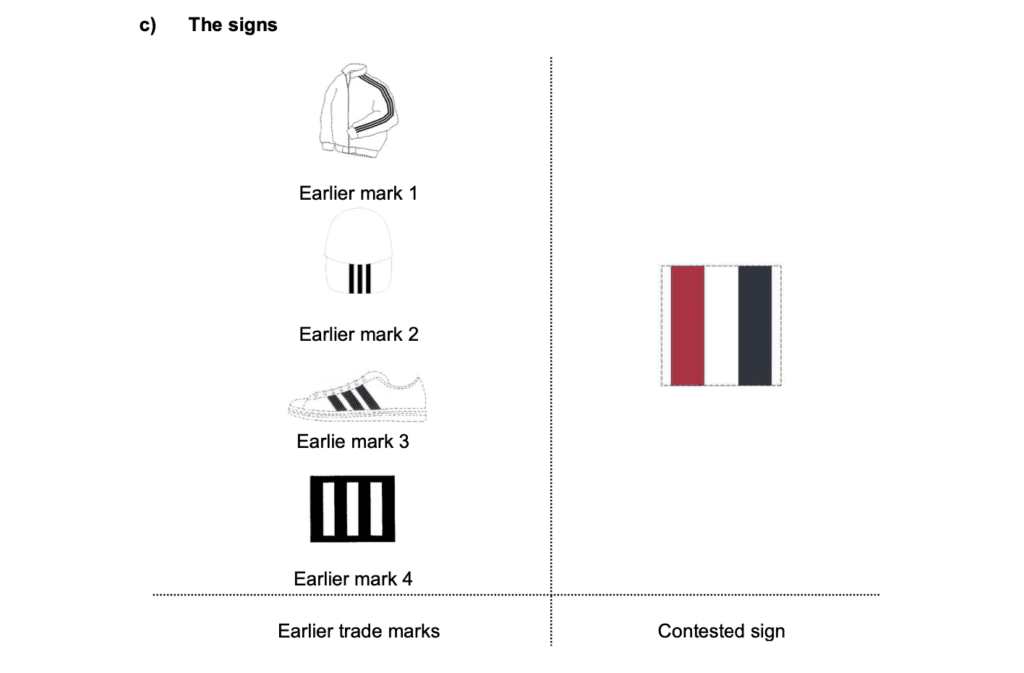Thom Browne has prevailed in the latest round of a trademark opposition proceeding waged against it by adidas in the European Union. In a decision on January 26, the Opposition Division for the European Union Intellectual Office (“EUIPO”) sided with the American fashion brand, finding that “when viewed as a whole,” adidas and Thom Browne’s respective striped trademarks “convey sufficient distance in their overall impressions” and thus, despite adidas’ claims to the contrary, the differences between the two companies’ marks make it unlikely that consumers will be confused as to the source of products bearing those marks.
Some Background: In February 2018, adidas initiated an opposition, in which it looked to block the registration of a multi-stripe trademark for use across an array of goods/services; Thom Browne filed an application (No. 17458837) for the contested mark – which is “a figurative sign composed of five adjacent stripes” – with the EUIPO in November 2017. Adidas subsequently amended its opposition to take issue exclusively with goods in Class 18 and 25 (namely, clothing, footwear, and leather goods). According to adidas, Thom Browne’s mark would likely confuse consumers due to the similarity to four of its own 3-stripe registrations (for use on clothing, footwear, leather goods, sporting equipments, etc.), which it argues had acquired “enhanced distinctiveness in the European Union, including Germany and Benelux,” before Browne filed its application.

Setting the stage in its decision, the EUIPO’s Opposition Division sided with adidas, in part, finding that its trademarks “have acquired enhanced distinctiveness and reputation in the European Union, including Germany and Benelux, for part of the goods for which [it] has claimed [to enjoy such a] reputation,” namely, footwear, clothing, headgear, and sporting equipment. The Board made this determination based on evidence provided by adidas, finding (among other things) that …
> “It is clear from the evidence that [adidas’] trademarks have been subject to long-standing and intensive use and are generally known in the relevant market, where they enjoy a consolidated position among the leading brands, as has been attested by diverse independent sources;”
> “The material recounting the history of [adidas’] marks, in particular its promotional and advertising activities throughout the years, show not only [adidas’] strategic effort to develop an image around this trademark, but also the scale and size of the investment undertaken to promote this image continuously throughout the relevant period and territory;”
> “The [three-stripe] mark is considered an ‘icon’ and a ‘superstar’ by various press articles in the relevant territory;” and
> “The sales figures, marketing expenditure and market share shown by the evidence, and the various references in the press to its success, all unequivocally show that the marks enjoy a high degree of recognition among the relevant public.”
Despite this favorable determination for adidas, the Opposition Division, nonetheless, found that adidas and Thom Browne’s marks are different enough to avoid a likelihood of consumer confusion. Delving into its LOC analysis, the Opposition Division first looked to the goods at issue, stating that they are “assumed to be identical,” as they “mainly target the public at large and (to some extent) business customers with specific professional knowledge or expertise” in the EU, Germany and Benelux.
As for the similarity of the two parties’ striped marks, the Opposition Division held that from a visual standpoint, they are similar “in one characteristic: they are all composed of stripes.” However, it noted that “the number, arrangement and sequence of these stripes differ among the signs,” and thus, “the signs are visually similar to a low degree.” Given that the marks are purely figurative, the potential for aural similarity is not relevant here, according to the Opposition Division. Finally, from a concept standpoint, the Opposition Division stated that since “none of the signs has a meaning for the public in the relevant territory … a conceptual comparison is not possible [and thus], the conceptual aspect does not influence the assessment of the similarity of the signs.”
TLDR: “The signs are visually similar to a low degree, to the extent that they share basic elements, such as stripes.” The Opposition Division held that “the arrangement and colors of the stripes in the signs are different [and] consumers are capable of perceiving differences between the stylization of signs.” It continued on, stating that “in the context of the overall visual assessment of the marks at issue, despite some resemblances, the differences between them, as shown in the previous paragraphs, prevail and lead to a sufficiently distant visual impression.” As such, “the different elements [between the two companies’ marks] are clearly perceivable and sufficient to exclude any likelihood of confusion between the marks.”
In other words … “Consumers are unlikely to confuse the marks, including believing that they originate from the same undertaking or from economically related undertakings. Therefore … the differences between the signs are sufficient to prevent a likelihood of confusion.”
THE BIGGER PICTURE: The EUIPO opposition comes amid a long-running back-and-forth between adidas and Thom Browne in the U.S., where adidas filed a trademark infringement and dilution suit against Thom Browne with the U.S. District Court for the Southern District of New York in June 2021. A federal jury sided with Thom Browne in January 2023, finding that despite adidas’s arguments to the contrary, Thom Browne did not engage in trademark infringement or dilution by offering up apparel and footwear bearing a four-stripe motif. Adidas is currently pushing for a new trial in that still-ongoing case.











